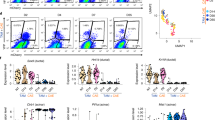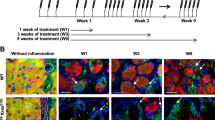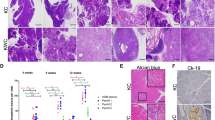Abstract
Pancreatic cancer remains as one of the most deadly cancers with few treatment options at late stages and little information about how it develops through earlier stages. Activating mutation of the Kras gene has been implicated in, but is not sufficient for, tumorigenesis. In mouse models of pancreatic cancer, loss of tumor suppressor genes in conjunction with Kras mutation leads to gradual stochastic acquisition of neoplastic precursors and carcinomas, whereas many cells remain phenotypically unaltered in younger mice. Here, we demonstrate that two oncogenic events, mutation of Kras and production of the growth factor heparin-binding epidermal growth factor-like growth factor (HB-EGF), are sufficient for rapid and complete neoplastic transformation of the exocrine pancreas. We found that macrophages are the major source of HB-EGF production in pancreatic cancer tissue samples, and that macrophages are present in high density and in close association with human pancreatic cancer lesions. In a mouse model, high macrophage density was observed at the earliest stages of neoplastic transformation. The consequence of elevated HB-EGF signaling was investigated without the confounding effects of other macrophage-produced factors via transgenic overexpression of the active form of HB-EGF. In this model, HB-EGF was sufficient to promote Kras-initiated tumorigenesis, inducing rapid and complete neoplastic transformation of the entire exocrine pancreas shortly after birth. HB-EGF overexpression and KrasG12D together, but neither alone, increased proliferation with increased cyclinD1 and decreased Cdkn2a/2d (p16/p19Ink4A/Arf). These findings establish the importance of oncogenic synergy in cancer initiation and promotion, and establish a molecular link between inflammation and the earliest stages of tumor induction.
This is a preview of subscription content, access via your institution
Access options
Subscribe to this journal
Receive 50 print issues and online access
$259.00 per year
only $5.18 per issue
Buy this article
- Purchase on Springer Link
- Instant access to full article PDF
Prices may be subject to local taxes which are calculated during checkout








Similar content being viewed by others
References
Almoguera C, Shibata D, Forrester K, Martin J, Arnheim N, Perucho M . Most human carcinomas of the exocrine pancreas contain mutant c-K-ras genes. Cell 1988; 53: 549–554.
Smit VT, Boot AJ, Smits AM, Fleuren GJ, Cornelisse CJ, Bos JL . KRAS codon 12 mutations occur very frequently in pancreatic adenocarcinomas. Nucleic Acids Res 1988; 16: 7773–7782.
Warshaw AL, Fernandez-del Castillo C . Pancreatic carcinoma. N Engl J Med 1992; 326: 455–465.
Luttges J, Reinecke-Luthge A, Mollmann B, Menke MA, Clemens A, Klimpfinger M et al. Duct changes and K-ras mutations in the disease-free pancreas: analysis of type, age relation and spatial distribution. Virchows Arch 1999; 435: 461–468.
Brand RE, Lerch MM, Rubinstein WS, Neoptolemos JP, Whitcomb DC, Hruban RH et al. Advances in counselling and surveillance of patients at risk for pancreatic cancer. Gut 2007; 56: 1460–1469.
Hruban RH, Adsay NV, Albores-Saavedra J, Compton C, Garrett ES, Goodman SN et al. Pancreatic intraepithelial neoplasia: a new nomenclature and classification system for pancreatic duct lesions. Am J Surg Pathol 2001; 25: 579–586.
Aguirre AJ, Bardeesy N, Sinha M, Lopez L, Tuveson DA, Horner J et al. Activated Kras and Ink4a/Arf deficiency cooperate to produce metastatic pancreatic ductal adenocarcinoma. Genes Dev 2003; 17: 3112–3126.
Hingorani SR, Petricoin EF, Maitra A, Rajapakse V, King C, Jacobetz MA et al. Preinvasive and invasive ductal pancreatic cancer and its early detection in the mouse. Cancer Cell 2003; 4: 437–450.
Hingorani SR, Wang L, Multani AS, Combs C, Deramaudt TB, Hruban RH et al. Trp53R172H and KrasG12D cooperate to promote chromosomal instability and widely metastatic pancreatic ductal adenocarcinoma in mice. Cancer Cell 2005; 7: 469–483.
Vitale-Cross L, Amornphimoltham P, Fisher G, Molinolo AA, Gutkind JS . Conditional expression of K-ras in an epithelial compartment that includes the stem cells is sufficient to promote squamous cell carcinogenesis. Cancer Res 2004; 64: 8804–8807.
Hansel DE, Kern SE, Hruban RH . Molecular pathogenesis of pancreatic cancer. Annu Rev Genomics Hum Genet 2003; 4: 237–256.
Ijichi H, Chytil A, Gorska AE, Aakre ME, Fujitani Y, Fujitani S et al. Aggressive pancreatic ductal adenocarcinoma in mice caused by pancreas-specific blockade of transforming growth factor-beta signaling in cooperation with active Kras expression. Genes Dev 2006; 20: 3147–3160.
Kojima K, Vickers SM, Adsay NV, Jhala NC, Kim HG, Schoeb TR et al. Inactivation of Smad4 accelerates Kras(G12D)-mediated pancreatic neoplasia. Cancer Res 2007; 67: 8121–8130.
Kobrin MS, Funatomi H, Friess H, Buchler MW, Stathis P, Korc M . Induction and expression of heparin-binding EGF-like growth factor in human pancreatic cancer. Biochem Biophys Res Commun 1994; 202: 1705–1709.
Korc M, Chandrasekar B, Yamanaka Y, Friess H, Buchier M, Beger HG . Overexpression of the epidermal growth factor receptor in human pancreatic cancer is associated with concomitant increases in the levels of epidermal growth factor and transforming growth factor alpha. J Clin Invest 1992; 90: 1352–1360.
Zhu Z, Kleeff J, Friess H, Wang L, Zimmermann A, Yarden Y et al. Epiregulin is Up-regulated in pancreatic cancer and stimulates pancreatic cancer cell growth. Biochem Biophys Res Commun 2000; 273: 1019–1024.
Holbro T, Hynes NE . ErbB receptors: directing key signaling networks throughout life. Annu Rev Pharmacol Toxicol 2004; 44: 195–217.
Beatty GL, Chiorean EG, Fishman MP, Saboury B, Teitelbaum UR, Sun W et al. CD40 agonists alter tumor stroma and show efficacy against pancreatic carcinoma in mice and humans. Science 2011; 331: 1612–1616.
Clark CE, Hingorani SR, Mick R, Combs C, Tuveson DA, Vonderheide RH . Dynamics of the immune reaction to pancreatic cancer from inception to invasion. Cancer Res 2007; 67: 9518–9527.
Ito Y, Higashiyama S, Takeda T, Yamamoto Y, Wakasa KI, Matsuura N . Expression of heparin-binding epidermal growth factor-like growth factor in pancreatic adenocarcinoma. Int J Gastrointest Cancer 2001; 29: 47–52.
Ray KC, Blaine SA, Washington MK, Braun AH, Singh AB, Harris RC et al. Transmembrane and soluble isoforms of heparin-binding epidermal growth factor-like growth factor regulate distinct processes in the pancreas. Gastroenterology 2009; 137: 1785–1794.
Doyle CM, Jamieson JD . Development of secretagogue response in rat pancreatic acinar cells. Dev Biol 1978; 65: 11–27.
Means AL, Meszoely IM, Suzuki K, Miyamoto Y, Rustgi AK, Coffey RJ et al. Pancreatic epithelial plasticity mediated by acinar cell transdifferentiation and generation of nestin-positive intermediates. Development 2005; 132: 3767–3776.
Odegaard JI, Chawla A . Alternative macrophage activation and metabolism. Annu Rev Pathol 2011; 6: 275–297.
Ji B, Tsou L, Wang H, Gaiser S, Chang DZ, Daniluk J et al. Ras activity levels control the development of pancreatic diseases. Gastroenterology 2009; 137: 1072–1082 82 e1-6.
Frykberg L, Palmieri S, Beug H, Graf T, Hayman MJ, Vennstrom B . Transforming capacities of avian erythroblastosis virus mutants deleted in the erbA or erbB oncogenes. Cell 1983; 32: 227–238.
Sinn E, Muller W, Pattengale P, Tepler I, Wallace R, Leder P . Coexpression of MMTV/v-Ha-ras and MMTV/c-myc genes in transgenic mice: synergistic action of oncogenes in vivo. Cell 1987; 49: 465–475.
Thompson TC, Southgate J, Kitchener G, Land H . Multistage carcinogenesis induced by ras and myc oncogenes in a reconstituted organ. Cell 1989; 56: 917–930.
Hanlon L, Avila JL, Demarest RM, Troutman S, Allen M, Ratti F et al. Notch1 functions as a tumor suppressor in a model of K-ras-induced pancreatic ductal adenocarcinoma. Cancer Res 2010; 70: 4280–4286.
Kinzler KW, Vogelstein B . Lessons from hereditary colorectal cancer. Cell 1996; 87: 159–170.
Carriere C, Young AL, Gunn JR, Longnecker DS, Korc M . Acute pancreatitis markedly accelerates pancreatic cancer progression in mice expressing oncogenic Kras. Biochem Biophys Res Commun 2009; 382: 561–565.
Morris JPt CanoDA, Sekine S, Wang SC, Hebrok M . Beta-catenin blocks Kras-dependent reprogramming of acini into pancreatic cancer precursor lesions in mice. J Clin Invest 2010; 120: 508–520.
Higashiyama S, Abraham JA, Miller J, Fiddes JC, Klagsbrun M . A heparin-binding growth factor secreted by macrophage-like cells that is related to EGF. Science 1991; 251: 936–939.
Edwards JP, Zhang X, Frauwirth KA, Mosser DM . Biochemical and functional characterization of three activated macrophage populations. J Leukoc Biol 2006; 80: 1298–1307.
Goswami S, Sahai E, Wyckoff JB, Cammer M, Cox D, Pixley FJ et al. Macrophages promote the invasion of breast carcinoma cells via a colony-stimulating factor-1/epidermal growth factor paracrine loop. Cancer Res 2005; 65: 5278–5283.
Blaine SA, Ray KC, Anunobi R, Gannon MA, Washington MK, Means AL . Adult pancreatic acinar cells give rise to ducts but not endocrine cells in response to growth factor signaling. Development 2010; 137: 2289–2296.
Gangarosa LM, Sizemore N, Graves-Deal R, Oldham SM, Der CJ, Coffey RJ . A raf-independent epidermal growth factor receptor autocrine loop is necessary for Ras transformation of rat intestinal epithelial cells. J Biol Chem 1997; 272: 18926–18931.
Oldham SM, Cox AD, Reynolds ER, Sizemore NS, Coffey RJ, Der CJ . Ras, but not Src, transformation of RIE-1 epithelial cells is dependent on activation of the mitogen-activated protein kinase cascade. Oncogene 1998; 16: 2565–2573.
Ardito CM, Gruner BM, Takeuchi KK, Lubeseder-Martellato C, Teichmann N, Mazur PK et al. EGF receptor is required for KRAS-induced pancreatic tumorigenesis. Cancer Cell 2012; 22: 304–317.
Mohammed A, Janakiram NB, Li Q, Madka V, Ely M, Lightfoot S et al. The epidermal growth factor receptor inhibitor gefitinib prevents the progression of pancreatic lesions to carcinoma in a conditional LSL-KrasG12D/+ transgenic mouse model. Cancer Prev Res (Phila) 2010; 3: 1417–1426.
Navas C, Hernandez-Porras I, Schuhmacher AJ, Sibilia M, Guerra C, Barbacid M . EGF receptor signaling is essential for k-ras oncogene-driven pancreatic ductal adenocarcinoma. Cancer Cell 2012; 22: 318–330.
Wang X, Proud CG . mTORC1 signaling: what we still don’t know. J Mol Cell Biol 2011; 3: 206–220.
Siveke JT, Einwachter H, Sipos B, Lubeseder-Martellato C, Kloppel G, Schmid RM . Concomitant pancreatic activation of Kras(G12D) and Tgfa results in cystic papillary neoplasms reminiscent of human IPMN. Cancer Cell 2007; 12: 266–279.
Elenius K, Paul S, Allison G, Sun J, Klagsbrun M . Activation of HER4 by heparin-binding EGF-like growth factor stimulates chemotaxis but not proliferation. Embo J 1997; 16: 1268–1278.
Kawaguchi Y, Cooper B, Gannon M, Ray M, MacDonald RJ, Wright CV . The role of the transcriptional regulator Ptf1a in converting intestinal to pancreatic progenitors. Nat Genet 2002; 32: 128–134.
Blaine SA, Ray KC, Branch KM, Robinson PS, Whitehead RH, Means AL . Epidermal growth factor receptor regulates pancreatic fibrosis. Am J Physiol Gastrointest Liver Physiol 2009; 297: G434–G441.
Acknowledgements
We thank R Daniel Beauchamp for support and helpful discussions, Steven D Leach, Barbara Fingleton and Harold L Moses for critically reading the manuscript, and Heidi Moreno and Christian Kis for technical assistance. This work was supported by NIH grants CA123061 (ALM), P30DK058404 and P50CA095103 (MKW), CA136754, VA Merit, and the Knapp Chair in Pancreatic Cancer Research (HCC).
Author information
Authors and Affiliations
Corresponding author
Ethics declarations
Competing interests
The authors declare no conflict of interest.
Additional information
Supplementary Information accompanies the paper on the Oncogene website
Supplementary information
Rights and permissions
About this article
Cite this article
Ray, K., Moss, M., Franklin, J. et al. Heparin-binding epidermal growth factor-like growth factor eliminates constraints on activated Kras to promote rapid onset of pancreatic neoplasia. Oncogene 33, 823–831 (2014). https://doi.org/10.1038/onc.2013.3
Received:
Revised:
Accepted:
Published:
Issue Date:
DOI: https://doi.org/10.1038/onc.2013.3
Keywords
This article is cited by
-
Identification of M2 macrophages in anterior pituitary glands of normal rats and rats with estrogen-induced prolactinoma
Cell and Tissue Research (2017)
-
The Arkadia-ESRP2 axis suppresses tumor progression: analyses in clear-cell renal cell carcinoma
Oncogene (2016)
-
New Insights into Diabetes Cell Therapy
Current Diabetes Reports (2016)
-
Smoking accelerates pancreatic cancer progression by promoting differentiation of MDSCs and inducing HB-EGF expression in macrophages
Oncogene (2015)
-
BAG3 promotes pancreatic ductal adenocarcinoma growth by activating stromal macrophages
Nature Communications (2015)



